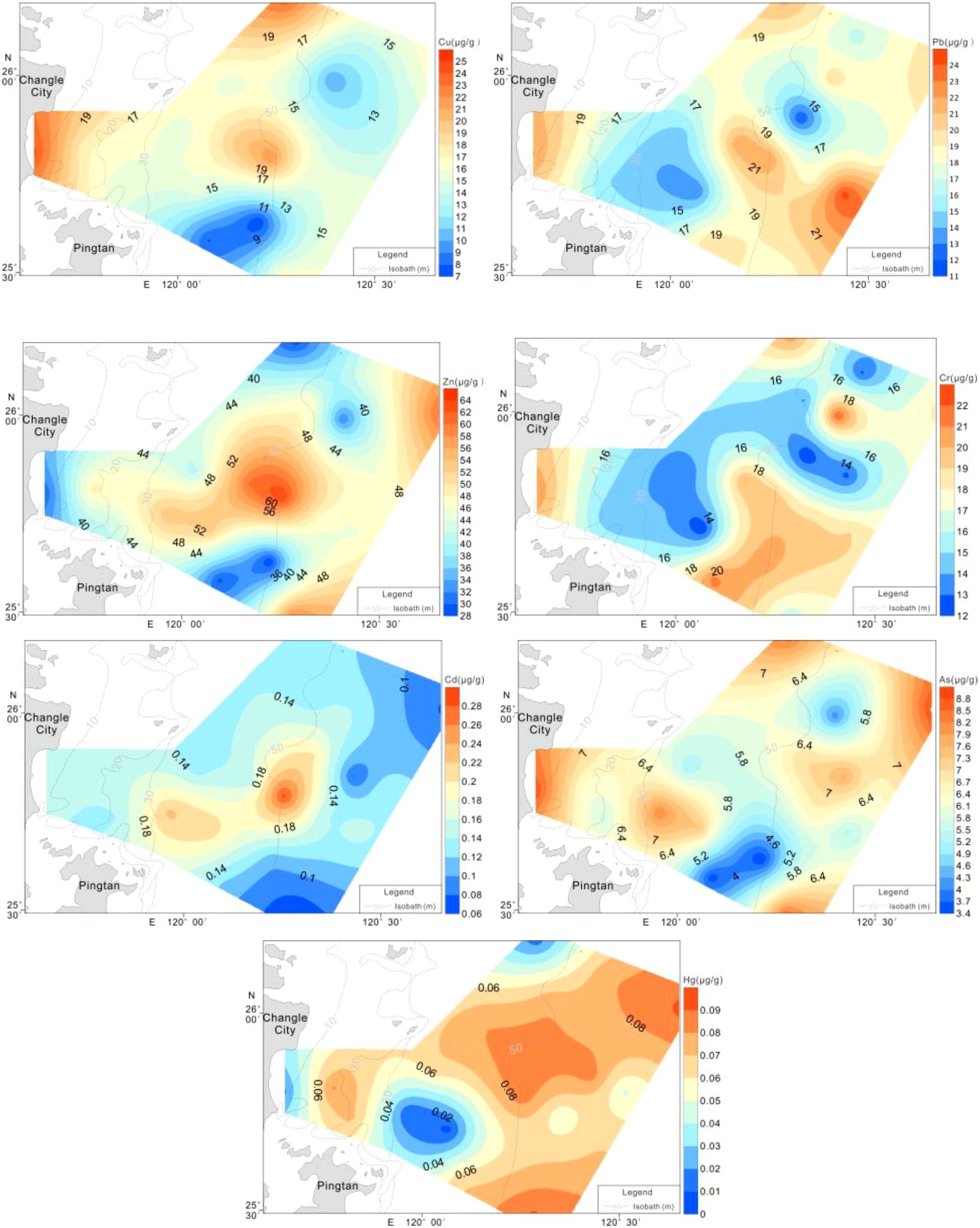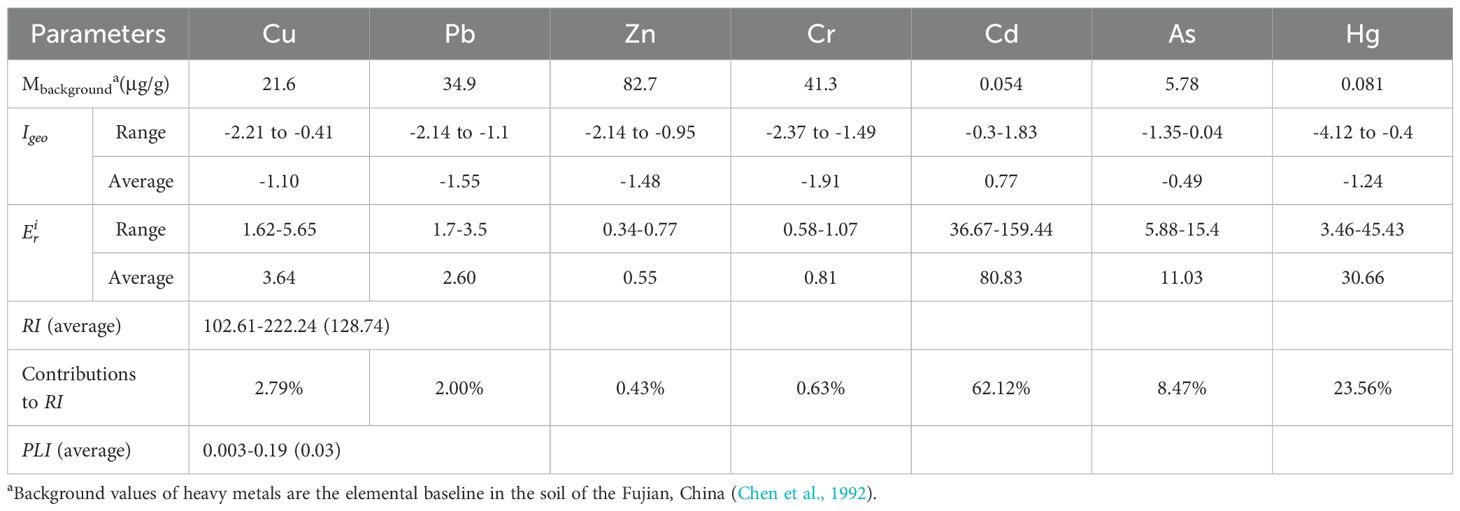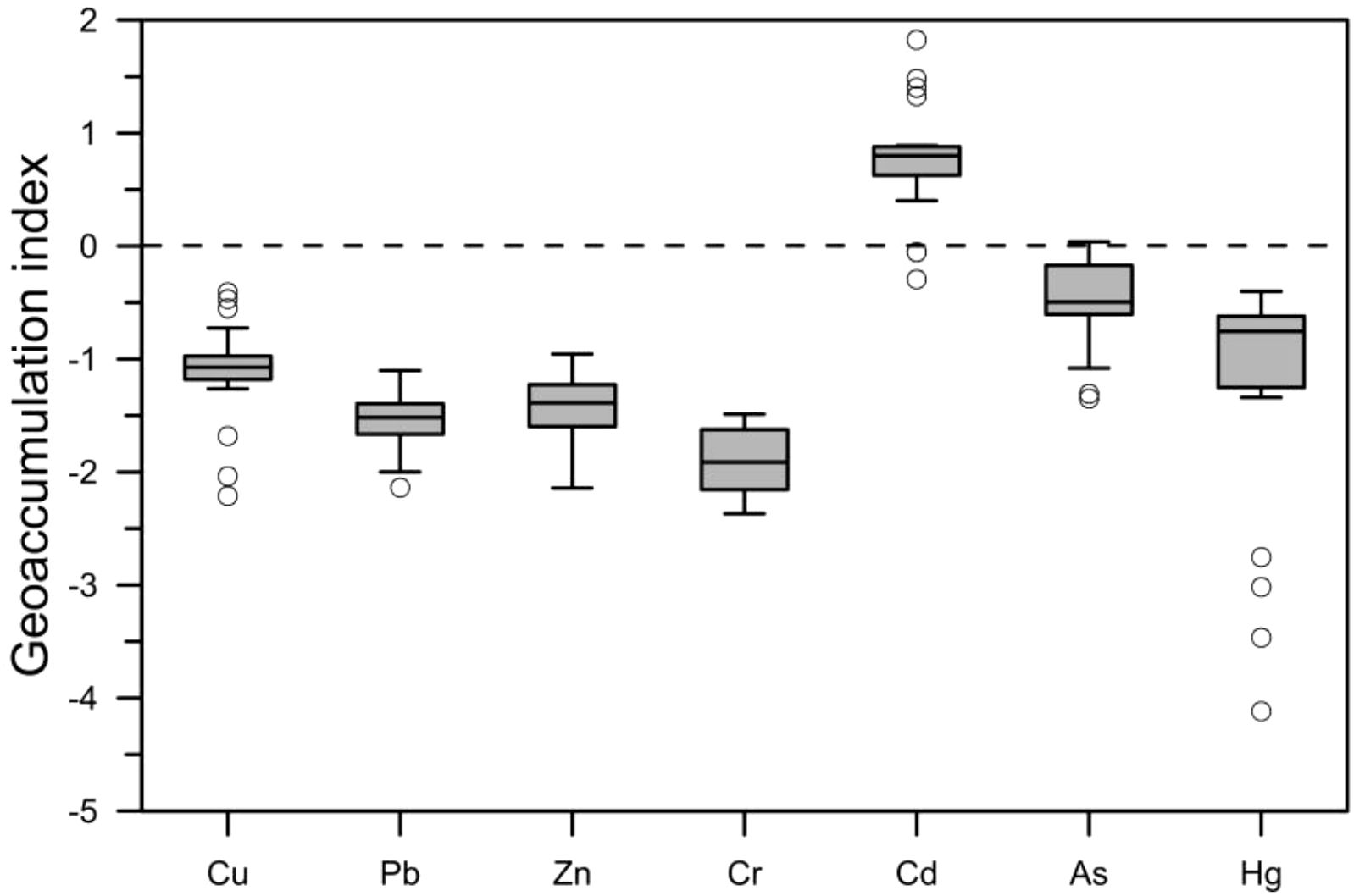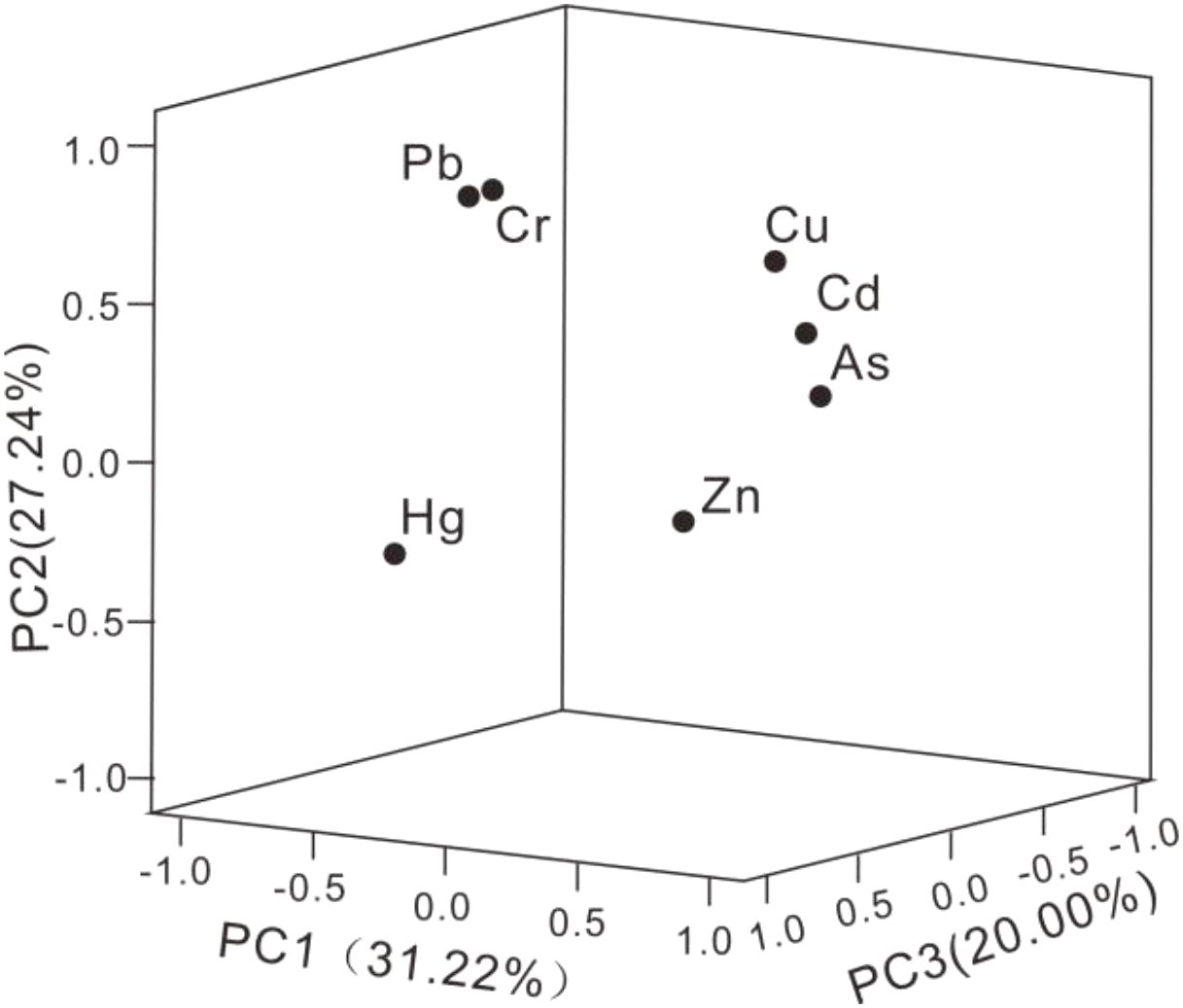- 1Third Institute of Oceanology, Ministry of Natural Resources, Xiamen, China
- 2Qingdao Institute of Marine Geology, China Geological Survey, Qingdao, China
The coastal area of Pingtan in Fujian Province holds strategic importance in the development of the Western Taiwan Strait Free Trade Zone, yet the issue of heavy metal pollution has come to the fore in recent years. This study focuses on the Pingtan coastal area of Fujian Province, China, employing field surveys, sample collection, and laboratory analyses integrated with multivariate statistical and spatial analysis techniques to investigate the interplay of natural and anthropogenic factors in the sources and distribution of heavy metals. The results indicate that the concentrations of Cu, Pb, Zn, Cr, Cd, As, and Hg in surface sediments all comply with the Class I standards of China’s Marine Sediment Quality Criteria. Hg exhibits the highest coefficient of variation, reflecting significant spatial heterogeneity, while the remaining elements demonstrate moderate CVs and relatively uniform distributions. Compared with Xiamen, Meizhou, and Xinghua Bays, Pingtan shows lower mean concentrations for most heavy metals. Spatial distribution patterns reveal distinct regional heterogeneity in heavy metals, with the formation of high- and low-concentration zones influenced by both natural and anthropogenic factors. The geoaccumulation index indicates that Cd exhibits relatively higher pollution levels, with mild to moderate contamination in some areas, while As shows slight pollution in two stations. The pollution load index suggests that the study area remains uncontaminated overall. Ecological risk assessment demonstrates that, apart from Cd, all other heavy metals pose low ecological risks. Cd presents moderate to high ecological risk, serving as the primary contributor to overall risk, followed by Hg, resulting in a moderate comprehensive ecological risk level for the region. Pearson correlation analysis reveals significant correlations among certain heavy metals, indicating shared sources or similar migration and transformation patterns, while other elements exhibit weak or negative correlations, suggesting divergent origins or environmental behaviors. Principal component analysis extracts four principal components, representing natural sources, anthropogenic sources (primarily industrial emissions and traffic pollution), mixed sources, and agricultural/phosphorus fertilizer inputs, respectively. This highlights the complexity of heavy metal sources and the intricate interactions between natural and anthropogenic factors in governing their distribution and accumulation patterns.
1 Introduction
Coastal zones, as critical interfaces between terrestrial and marine ecosystems, exhibit highly sensitive and complex ecological environments (Madadi et al., 2023: Nour and Aljahdali, 2025). The Pingtan coastal area of Fujian Province, characterized by its unique geographical location and dynamic economic activities, plays a pivotal role in regional development (Alharbi et al., 2024; Lin, 2012). However, in recent years, accelerated industrialization, urbanization, and intensive exploitation of marine resources have posed increasingly severe environmental challenges to this region, with heavy metal pollution emerging as a particularly prominent issue (Liu et al., 2025). Persistent in marine environments, heavy metals accumulate in biological systems and exhibit significant toxicity, adversely affecting marine organisms’ physiological functions and reproductive success (Avvari et al., 2022; Kwon and Lee, 1998). These contaminants can biomagnify through marine food webs, eventually posing substantial health risks to human populations that rely on seafood (Qiu et al., 2019; Nour et al., 2022).
Lithogenic factors dominate the provenance and initial distribution of heavy metals in coastal ecosystems (Yu et al., 2010). Pingtan’s specific geochemical environment, characterized by its unique stratigraphy and weathering profiles, establishes regional geochemical baselines (Lv et al., 2019). Coastal hydrodynamics then mediate metal transport, with tidal flushing and current systems controlling their ultimate marine distribution (Liu et al., 2009). Anthropogenic pressures are now substantially altering these natural regulatory mechanisms. Industrial wastewater discharge, agricultural non-point source pollution, transportation, and urban construction have introduced substantial additional heavy metals into the environment, profoundly disrupting and even overriding natural distribution patterns, resulting in anomalous enrichment phenomena in localized areas (Kwok et al., 2014; Liu et al., 2003).
A comprehensive investigation of the interaction mechanisms between natural and anthropogenic factors in governing heavy metal sources and distribution in the Pingtan coastal area holds significant scientific value. Such research not only facilitates a thorough understanding of pollution formation processes and precise identification of contamination sources but also provides a robust theoretical foundation for developing scientifically sound pollution control and ecological remediation strategies. Previous studies on heavy metal pollution in the Pingtan coastal area have predominantly focused on single-factor analyses, with relatively limited systematic research addressing the complex interplay between natural and anthropogenic factors. This study aims to: 1) quantify the concentrations and spatial distribution of heavy metals in surface sediments of the Pingtan coastal area; 2) assess the pollution levels and ecological risks of heavy metals using geoaccumulation index, pollution load index, and potential ecological risk index; 3) identify the interactive effects of natural (geological background, hydrodynamic processes) and anthropogenic factors (industrial emissions, agricultural activities) on heavy metal sources and distribution patterns; 4) apportion the sources of heavy metals through multivariate statistical analysis (Pearson correlation, principal component analysis) to inform targeted pollution control strategies. The study will advance the understanding of heavy metal pollution in coastal areas, particularly in Pingtan. By integrating natural and anthropogenic factors, it will reveal the complex interplay governing heavy metal distribution and address a gap in previous single-factor studies, offering a model for similar coastal zones.
2 Materials and methods
2.1 Sample collection and analytical methods
In November 2021, a total of 22 surface sediment samples were collected from Pingtan coastal area, Fujian Province (Figure 1). Surface sediments were collected using a grab sampler, and the upper 0-5 cm layer of sediment was carefully scooped and placed into clean polyethylene bags, which were then frozen for subsequent laboratory analysis. Prior to testing, the samples underwent pretreatment, which involved thawing, drying in an oven at 60°C, and grinding. The samples were then passed through a 200-mesh standard sieve. After digestion with a mixture of HNO3-HClO4-HCl, the concentrations of Cu, Pb, and Zn were determined using an X-ray fluorescence spectrometer (Model Axios PW4400). The concentrations of Cr and Cd were measured using an inductively coupled plasma mass spectrometer (Model Thermo X Series 2), while Hg and As were analyzed using a dual-channel atomic fluorescence spectrophotometer (Model AFS-920). The quality of sample processing and analysis was controlled using blank reagents, duplicate samples, and certified reference materials. The accuracy of the analysis was verified by employing the Offshore Marine Sediment Composition Analysis Standard Reference Material (GBW07314), following the same procedures as those applied to the samples. The recovery rates for all elements ranged between 90% and 110%, ensuring the reliability and consistency of the measurements. To assess the reproducibility of heavy metal concentrations, 10% of the samples were analyzed in triplicate. The standard deviation of the heavy metal concentrations in the parallel samples was less than 8%, and the recovery rate deviation for heavy metal concentrations was less than 9%.
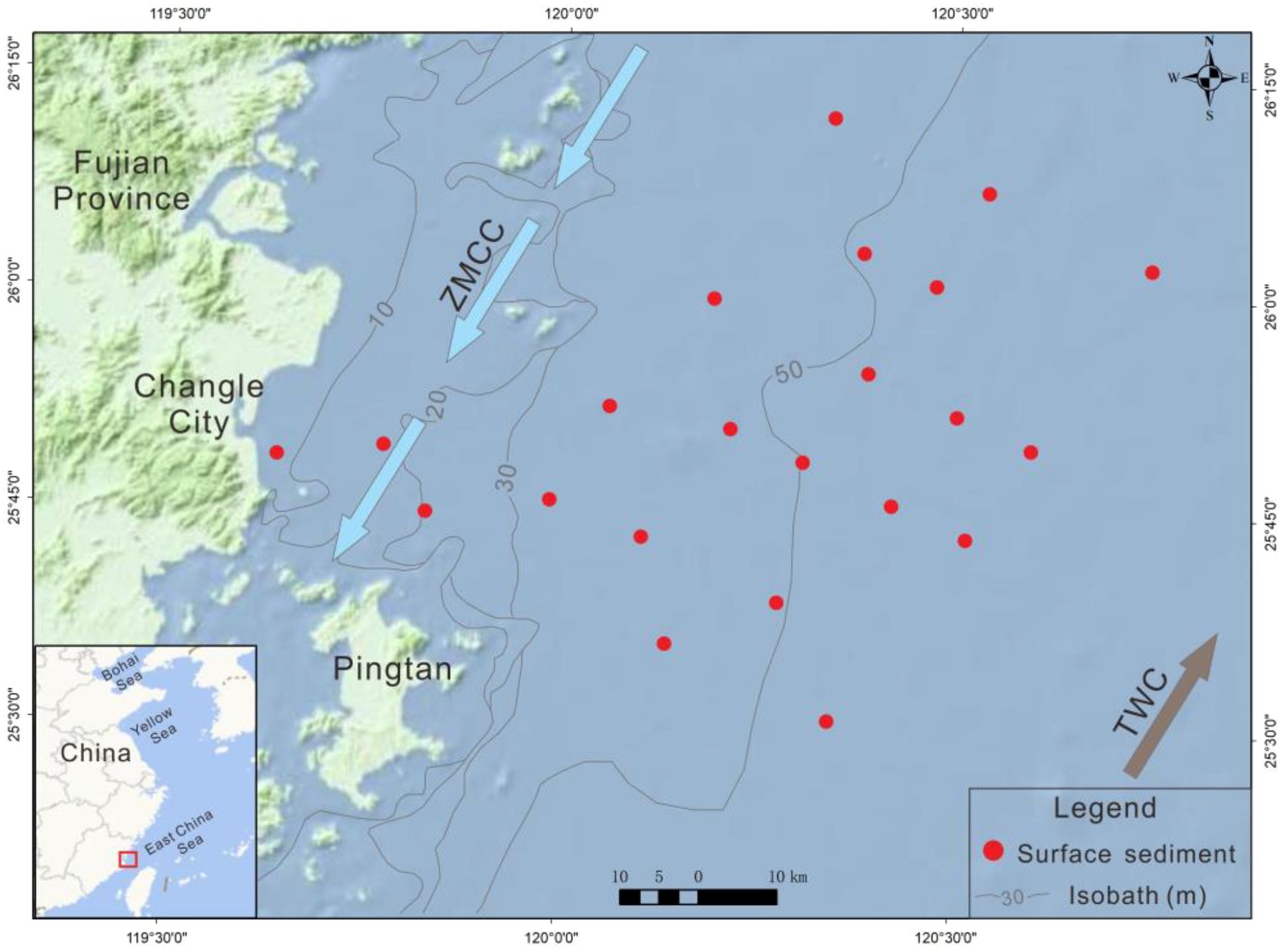
Figure 1. Locations of the surface sediment samples and the regional circulation pattern based on Xu et al. (2023). ZMCC, Zhe-Min coastal current in winter; TWC, Taiwan warm current.
2.2 Analytical assessment method
This study employed a comprehensive approach to evaluate heavy metal pollution hazards and trace their sources, incorporating geochemical indices (Igeo, PLI, RI) combined with multivariate statistical techniques (PCC and PCA).
The Igeo was determined using the following formula (Equation 1):
Here, Ci represents the heavy metal concentration in sediments, and Bi denotes the background values of the elemental baseline in the soil of the Fujian, China (Chen et al., 1992). The Igeo scale ranges from uncontaminated (Igeo ≤ 0) to severely contaminated (Igeo > 5), as defined by Muller (1981).
The PLI, developed by Tomlinson et al. (1980), evaluates the cumulative pollution status of multiple heavy metals. It is calculated as (Equation 2 and 3):
where CFi is the contamination factor for the ith heavy metal, Ci is the measured concentration, and C0 is the geochemical background value. A PLI< 1 indicates no pollution, while PLI > 1 signifies pollution (Chakravarty and Patgiri, 2009).
The RI assesses ecological risks by considering metal toxicity and background concentrations (Hakanson, 1980). It is calculated as (Equation 4):
Here, the contamination factor () for the ith heavy metal is calculated as the ratio of its measured concentration () to its geochemical background value (). The toxic response factor varies by metal, with assigned values as follows: Zn (1), Cr (2), Cu (5), Pb (5), As (10), Cd (30), and Hg (40) (Hakanson, 1980). The potential ecological risk index (RI) integrates the individual risks of multiple metals.
The ecological risk level for a single metal () is classified into five categories: low (<40), moderate (40–79), considerable (80–159), high (160–319), and very high (≥320). Similarly, the RI is categorized into four risk levels: low (RI< 105), moderate (105 ≤ RI< 210), significant (210 ≤ RI< 420), and very high (RI ≥ 420) (Xu et al., 2021).
3 Results and discussion
3.1 Heavy metal contents in surface sediments
The concentrations of Cu, Pb, Zn, Cr, Cd, As, and Hg in surface sediments from Pingtan coastal area exhibited ranges of 7-24.4, 11.9-24.4, 28.1-64, 12-22.1, 0.066-0.287, 3.4-8.9, and 0.007-0.092 μg/g, respectively, with corresponding mean values of 15.71, 18.18, 45.86, 16.83, 0.15, 6.37, and 0.06 μg/g (Table 1). All measured heavy metal concentrations in the sediments were found to comply with the first-class standards of the Chinese Marine Sediment Quality Criteria (GB 18668-2002; AQSIQ, 2002). The coefficient of variation (CV) was employed to assess the extent of anthropogenic influence on heavy metal distribution. Among the seven elements analyzed, the CV values followed the order: Hg > Cd > Cu > As > Zn > Cr > Pb (Table 1). Notably, the CV value of Hg was 43.44%, exceeding the threshold of 35%, which indicated significant spatial variability. This suggests that Hg was subject to substantial external inputs, leading to pronounced fluctuations and high data dispersion. In contrast, all of the remaining elements displayed moderate to low variability, with CV values between 17.41% and 34.65%, reflecting relatively uniform distributions across most sampling sites.
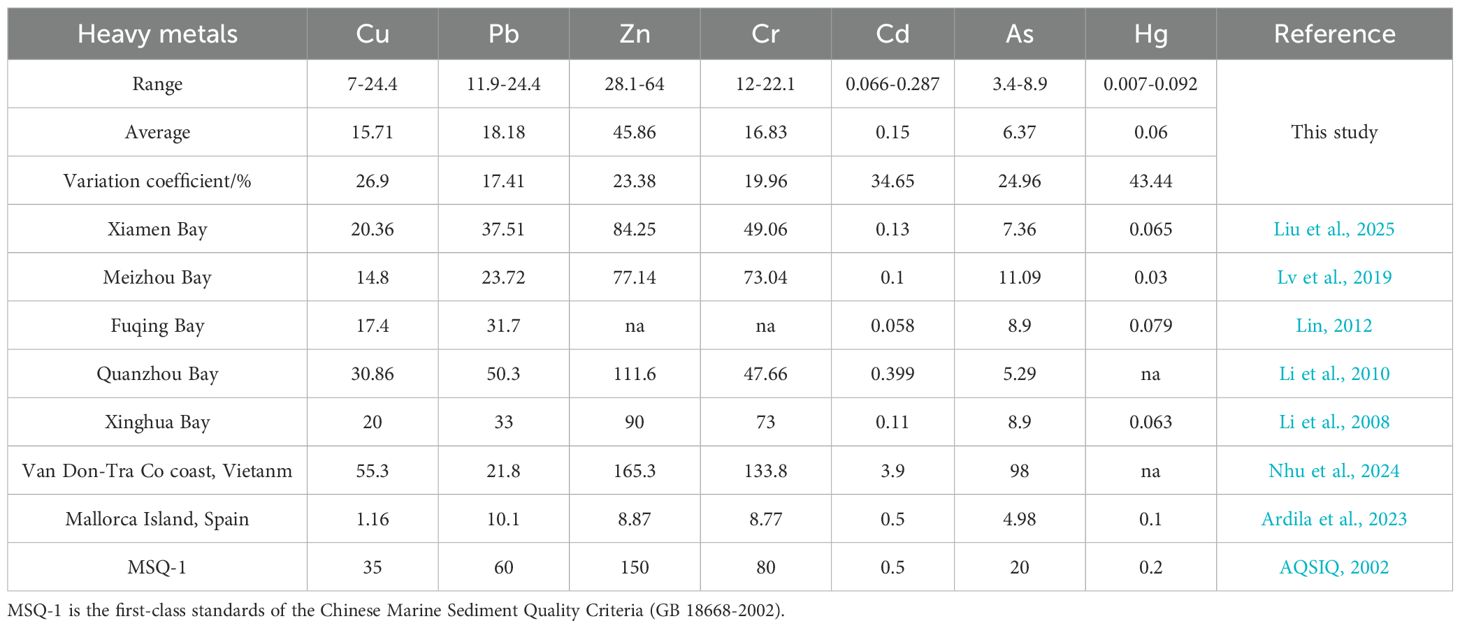
Table 1. Contents of heavy metals in the sediments in Pingtan coastal area and other areas (unit: μg/g).
Regional comparison of heavy metal concentrations revealed significant spatial heterogeneity, with Pingtan exhibiting distinct geochemical signatures. The coastal sediments contained substantially lower mean levels of Cu, Pb, Zn, Cr, and As compared to Xiamen Bay (Liu et al., 2025), with only Cd and Hg showing comparable concentrations. Relative to Meizhou Bay, Pingtan displayed reduced Cu, Pb, and As concentrations, while Zn and Cr showed even greater depletion (Lv et al., 2019). Interestingly, while Pb and As levels were lower than those in Fuqing Bay, Cd concentrations were slightly higher in Pingtan’s coastal sediments (Lin, 2012). A more substantial disparity was observed when comparing Pingtan with Quanzhou Bay, where all measured heavy metals, except As, displayed markedly lower concentrations (Li et al., 2010). Furthermore, Pingtan’s sediment showed reduced Pb, Zn, Cr, and As levels relative to Xinghua Bay, while Cu and Hg concentrations remained comparable (Li et al., 2008). Internationally, the heavy metal concentrations in Pingtan were significantly lower than those documented for the Van Don-Tra Co coastal region (Vietnam), particularly for Zn, Cr, Cd, and As (Nhu et al., 2024). Conversely, Pingtan exhibited higher Cu, Pb, Zn, Cr, and As levels than those recorded in Mallorca Island (Spain), though Cd and Hg concentrations were comparatively diminished (Ardila et al., 2023). Lower heavy metal concentrations in Pingtan compared to international regions can be attributed to geological differences, regulatory measures, natural dilution, and reduced industrial intensity. Mallorca’s sediments may derive from metal-poor bedrocks, while Vietnam’s coastal areas experience higher weathering of metal-rich rocks and untreated industrial discharges. Pingtan’s industrialization and urbanization are less intensive than in heavily developed regions, limiting anthropogenic inputs from untreated wastewater or atmospheric deposition.
3.2 Spatial distribution of heavy metals
Figure 2 displays the distribution characteristics of seven heavy metal elements (Cu, Pb, Zn, Cr, Cd, As, and Hg) in the coastal waters near Pingtan, Fujian. Pb and Cr shows similar distribution with the high concentrations appeared in the southeastern of the study area and the coastal area near Chengle City. The high concentrations of Cu, Zn, Cd, and Hg are found in the middle of the study area, which maybe attributed to sediment type, with finer-grained sediments exhibiting stronger adsorption capacity for heavy metals and consequently higher concentrations. The distribution of As is characterized by irregularity and the presence of sporadic occurrences.
3.3 Assessment of heavy metals pollution in sediments
The Igeo values for Cu, Pb, Zn, Cr, Cd, As, and Hg in the sediments in Pingtan coastal area ranged from -2.21 to -0.41, -2.14 to -1.1, -2.14 to -0.95, -2.37 to -1.49, -0.3 to 1.83, -1.35 to 0.04, and -4.12 to -0.4, respectively, with mean values of -1.10, -1.55, -1.48, -1.91, 0.77, -0.49, and -1.24, respectively (Table 2). The mean degree of contamination was highest for Cd, followed by As, Cu, Hg, Zn, Pb, and Cr. The Igeo values of Cd and As were greater than zero in 86.4%, and 9.1% of the samples, respectively (Figure 3). Almost the whole study area were slightly to moderately contaminated (0-2) by Cd (Muller, 1981).
The PLI values for twenty-two stations in the surface sediments ranged from 0.003 to 0.19, with an average values of 0.03 (Table 2). The spatial distribution of PLI values was shown in Figure 4. The PLI values in the study area were less than 1, indicating that there was no pollution on the whole.
The individual potential ecological risk coefficients for heavy metals in sediments were ranked in the following order: Cd > Hg > As > Cu > Pb > Cr > Zn (Table 2). With the exception of Cd, the mean values for the remaining heavy metals were all below 40, suggesting a low level of ecological risk (Table 2). However, Cd exhibited a notably higher range of 36.67–159.44, indicating a moderate to considerable ecological risk (Tam and Wong, 2000). The comprehensive potential ecological risk index (RI) across the study area ranged from 102.61 to 222.24, with an average value of 128.74 (Table 3), reflecting an overall moderate ecological risk. Notably, only one station in the central of the study area demonstrated significant ecological risk, with RI value ranging from 210 to 420 (Figure 4). Further analysis of the contributions of individual heavy metals to the overall RI revealed that Cd and Hg were the predominant contributor, accounting for 62.12% and 23.56% of the total risk (Table 2). This highlights that Cd and Hg pollution were the primary driver of ecological risk in the study area (Di Bella et al., 2024). Despite their relatively low concentration among the seven analyzed elements, Cd’s and Hg’s high biological toxicity significantly amplifies their ecological impact, underscoring their disproportionate influence on the overall risk assessment.
3.4 Interplay of natural and anthropogenic factors in source of heavy metals
The geology of the Pingtan coastal area is critical for identifying natural heavy metal sources due to unique rock types and soil parent materials (e.g., weathered igneous or sedimentary rocks) establish the natural background levels of elements, tidal currents (Zhe-Min Coastal Current, Taiwan Warm Current) and sediment transport patterns distribute naturally derived metals and geological structures affect metal speciation and mobility, such as pH and redox conditions in sediments influencing the release or fixation of naturally occurring metals.
Table 3 showed the Pearson correlation coefficients among the concentrations of heavy metals in the sediments. It can be seen that Cr and Pb exhibited a significant positive correlation (r = 0.823, p< 0.01), indicating that these two heavy metal elements share similar sources or exhibit comparable migration and transformation patterns in the study area. This relationship may arise from common influencing factors, such as shared geological origins or analogous geochemical processes during sedimentation (Hoai et al., 2020). Statistical analysis revealed a strong positive correlation between Cu and As (r=0.639, p<0.01), indicative of their co-occurrence patterns. This relationship likely stems from their similar ionic radii and electronegativity, promoting parallel transport and accumulation dynamics. Conversely, Zn, Cd and Hg exhibited minimal correlation with other elements, potentially reflecting: (1) discrete input sources or (2) differential responses to sedimentological controls (e.g., organic matter affinity, grain size effects). Particularly noteworthy was the inverse relationship between Zn-Pb (r=-0.141) and Cd-Hg (r=-0.403), suggesting fundamentally different biogeochemical cycling. For Zn-Pb, this may reflect contrasting source contributions (e.g., industrial vs. natural Pb inputs), while for Cd-Hg, differences in redox sensitivity and organic complexation likely drive their divergent behavior (Zhang et al., 2013). These patterns highlight the multifaceted controls on metal distributions in coastal sediments.
The distribution of heavy metals in sediments is influenced by both natural and anthropogenic factors, with natural factors establishing the baseline and anthropogenic factors exacerbating variations (Di Bella et al., 2024). Natural factors include geological background, riverine input, ocean circulation, and hydrodynamic conditions. Regional geological structures and rock types influence the baseline concentrations of heavy metals. In the northwestern part of the study area, rivers discharge substantial terrestrial materials, including industrial effluents, domestic sewage, and agricultural non-point source pollutants containing heavy metals. Near the river estuaries, the flow velocity decreases abruptly, causing heavy metals to settle with suspended sediments. This results in high-concentration zones of Cu, Pb, Zn, and Cd in the coastal waters near Changle City. For instance, untreated industrial wastewater containing copper and lead discharged into rivers will ultimately accumulate and deposit in estuarine areas.
Ocean circulation and hydrodynamic conditions significantly affect the transport and diffusion of heavy metals. The waters around Pingtan Island, influenced by Zhe-Min Coastal Current (ZMCC), exhibit strong hydrodynamic activity and frequent seawater exchange, which dilutes heavy metal concentrations, making this area a low-concentration zone. In contrast, regions with relatively weak currents and limited water exchange, such as the eastern coastal area of Changle City, facilitate the accumulation of heavy metals, forming high-concentration zones for elements like Hg.
Coastal industrial activities, urbanization, and marine operations contribute to heavy metal release into the marine environment (Ramadan et al., 2021). As an urbanized and industrialized region, Changle City generates substantial heavy metal pollutants from various anthropogenic activities. These pollutants enter the ocean through surface runoff and atmospheric deposition, leading to elevated concentrations of multiple heavy metals in adjacent coastal waters. Additionally, maritime activities such as shipping and aquaculture also contribute to localized heavy metal accumulation.
To identify the potential sources of heavy metals in the environment, PCA was performed using SPSS software. Four principal components with eigenvalues exceeding 1 were extracted, collectively explaining 93.44% of the total variance (Table 4). These components capture the majority of the variability in the original dataset, providing a robust representation of the underlying data structure (Waykar and Petare, 2016).
Principal component 1 (PC1), accounting for 31.22% of the total variance (Figure 5), exhibited strong loadings for Cu (0.63), Zn (0.60), and As (0.77), suggesting a common origin for these elements. The Igeo of Cu, Zn, and As were all below zero (Table 2), implying negligible anthropogenic contamination (Muller, 1981). Consequently, PC1 likely reflects a geogenic origin, with these metals predominantly sourced from natural rock weathering and erosional processes. Pb and Cr exhibited high positive loadings on PC2 (0.80 and 0.74, respectively), while Cu also showed a relatively high positive loading (0.66) on the same component. The PCA results reveal distinct compositional differences between PC2 and PC1 metal assemblages (Zhang et al., 2015). The PC2 grouping (explaining 27.24% variance) suggests shared environmental behaviors potentially influenced by: (1) industrial discharge patterns from local electroplating facilities, or (2) vehicular emission deposition. Notably, Hg and Cd exhibited unique loading patterns (PC3: Hg=0.83; PC4: Cd=0.78), indicating independent environmental controls. Hg’s strong PC3 loading may reflect atmospheric transport from coal combustion or waste incineration, while Cd’s PC4 dominance likely stems from agricultural inputs - particularly phosphorus fertilizer application (Zhou et al., 2022). This component segregation implies three dominant source regimes: industrial (PC2), atmospheric (PC3), and agronomic (PC4), necessitating targeted mitigation approaches (Huang et al., 2020).
Effective management of Cd and Hg contamination in Pingtan requires an integrated approach combining regulatory, technological, and monitoring interventions. Key measures should include: (1) Agricultural sector reforms through phosphorus fertilizer use optimization to reduce Cd inputs; (2) Industrial emission controls targeting Hg sources, particularly from coal combustion and waste incineration; (3) Enhanced enforcement of GB 18668-2002 standards with region-specific Cd/Hg thresholds reflecting local biogeochemical conditions; (4) Deployment of hyperaccumulator species (e.g., Sedum alfredii) for cost-effective Cd phytoremediation; and (5) Establishment of a comprehensive coastal monitoring network focusing on the Min River estuary’s sediment-water interface.
4 Conclusion
The concentrations of Cu, Pb, Zn, Cr, Cd, As, and Hg in surface sediments from the coastal area of Pingtan all comply with China’s Marine Sediment Quality Grade I standards. Hg exhibits the highest CV, indicating significant spatial variability, while the remaining elements show moderate CVs and relatively uniform distribution. Compared with other regions, the average concentrations of most heavy metals in Pingtan’s coastal area are lower. The spatial distribution of heavy metals displays distinct regional heterogeneity, with the formation of high- and low-concentration zones influenced by both natural and anthropogenic factors. The Igeo suggests that Cd exhibits relatively higher pollution levels, with some areas experiencing mild to moderate contamination, while As shows slight pollution in a few samples. The PLI indicates that the study area remains uncontaminated overall. Potential ecological risk assessment results reveal that, apart from Cd, all other heavy metals pose low ecological risks. Cd demonstrates moderate to high ecological risk, serving as the primary contributor to ecological risk in the study area, followed by Hg. The overall ecological risk level of the study area is moderate. Pearson correlation coefficient analysis reveals significant correlations among certain heavy metals, reflecting shared sources or similar migration and transformation patterns, while other elements exhibit weak or negative correlations, indicating divergent sources or environmental behaviors. PCA extracts four principal components, representing natural sources, anthropogenic sources (primarily industrial emissions and traffic pollution), mixed sources, and agricultural/phosphorus fertilizer inputs, respectively. This highlights the complexity of heavy metal sources and the intricate interplay of natural and anthropogenic factors in their distribution and accumulation patterns. Targeted management strategies should be implemented for heavy metals from different sources to mitigate environmental risks and promote ecological conservation and sustainable development in the coastal area of Pingtan.
The study design and data collection entail several limitations. First, the sampling framework with only 22 sites may overlook micro-scale spatial heterogeneity. Second, the absence of data on metal bioavailability (e.g., dissolved versus particulate fractions) restricts the precision of risk assessment. Third, dependence on soil data from Fujian Province (Chen et al., 1992) may inadequately characterize baseline conditions in marine sediments. Future research should incorporate multi-seasonal sampling, higher-resolution spatial sampling, and metal speciation analyses to address these gaps.
Data availability statement
The raw data supporting the conclusions of this article will be made available by the authors, without undue reservation.
Author contributions
CW: Funding acquisition, Conceptualization, Writing – original draft, Data curation. JB: Resources, Writing – original draft, Software. ZW: Writing – original draft, Formal analysis, Visualization, Conceptualization. ZC: Data curation, Writing – original draft, Formal analysis. YZ: Methodology, Investigation, Writing – original draft. HL: Supervision, Writing – original draft, Data curation.
Funding
The author(s) declare that financial support was received for the research and/or publication of this article. This study was funded by the Naming of Undersea Feature Based on Topograohic and Geomorphological Characteristics (TIO MR 2019005).
Conflict of interest
The authors declare that the research was conducted in the absence of any commercial or financial relationships that could be construed as a potential conflict of interest.
Generative AI statement
The author(s) declare that no Generative AI was used in the creation of this manuscript.
Any alternative text (alt text) provided alongside figures in this article has been generated by Frontiers with the support of artificial intelligence and reasonable efforts have been made to ensure accuracy, including review by the authors wherever possible. If you identify any issues, please contact us.
Publisher’s note
All claims expressed in this article are solely those of the authors and do not necessarily represent those of their affiliated organizations, or those of the publisher, the editors and the reviewers. Any product that may be evaluated in this article, or claim that may be made by its manufacturer, is not guaranteed or endorsed by the publisher.
References
Alharbi T., Nour H. E., Al-Kahtany K., Zumlot T., and El-Sorogy (2024). Health risk assessment andcontamination of lead andcadmium levels in sediments othe northwestern Arabian Gulf coast. Heliyon 10, e36447. doi: 10.1016/j.heliyon.2024.e36447
AQSIQ (2002). “Administration of quality supervision, inspection and quarantine of the People's Republic of China,” in Marine Sediment Quality of China (GB 18668-2002) (Standards Press of China, Beijing).
Ardila P., Alonso R., Valsero J., Garcia R., Cabrera D., Cosio E., et al. (2023). Assessment of heavy metal pollution in marine sediments from southwest of Mallorca island, Spain. Environ. Sci. pollut. Res. 30, 16852–16866. doi: 10.1007/s11356-022-25014-0
Avvari L., Basuri C., Chari H., Tirukkovalluri S., and Gollapalli N. (2022). Assessment of heavy metal distribution in seawaters of Kakinada Bay, a tropical mangrove-rich coastal environment. Mar. pollut. Bull. 181, 113877. doi: 10.1016/j.marpolbul.2022.113877
Chakravarty M. and Patgiri A. D. (2009). Metal pollution assessment in sediments of the Dikrong River, NE India. J. Hum. Ecol. 27, 63–67. doi: 10.31901/24566608.2009/27.01.08
Chen Z., Chen C., Liu Y., Wu Y., Yang S., and Lu C. (1992). Study on soil environmental background value in Fujian Province. Environ. Sci. 13, 70–75. doi: 10.13227/j.hjkx.1992.04.020
Di Bella G., El-Sorogy A. S., Giacobbe S., Nava V., Al-Kahtany K., and Nour H. E. (2024). Risk assessment of potentially toxic elements in intermittent rivers, "fiumara", flowing in the gulf of milazzo (sicily, Italy). Environ. Earth Sci. 83, 321. doi: 10.1007/s12665-024-11631-0
Hakanson L. (1980). An ecological risk index for aquatic pollution control.a sedimentological approach. Water Res. 14, 975–1001. doi: 10.1016/0043-1354(80)90143-8s
Hoai N., Thanh T., Manh H., Thung D., and Johnstone R. (2020). An assessment of heavy metal contamination in the surface sediments of Ha Long Bay, Vietnam. Environ. Earth Sci. 79, 436. doi: 10.1007/s12665-020-09192-z
Huang X., Wang X., Li X., Yan Z., and Sun Y. (2020). Occurrence and transfer of heavy metals in sediments and plants of Aegiceras corniculatum community in the Qinzhou Bay, southwestern China. Acta Oceanol. Sin. 39, 79–88. doi: 10.1007/s13131-020-1555-7
Kwok C., Liang Y., and Wang H. (2014). Bioaccumulation of heavy metals in fish and Ardeid at Pearl River estuary, China. Ecotoxicol. Environ. Saf. 106, 62–67. doi: 10.1016/j.ecoenv.2014.04.016
Kwon Y. T. and Lee C. W. (1998). Application of multiple ecological risk indices for the evaluation of heavy metal contamination in a coastal dredging area. Sci. Total Environ. 214, 203–210. doi: 10.1016/S0048-9697(98)00069-2
Li Y., Chen J., Huang C., Wang A., and Li D. (2010). Distribution patterns of heavy metals in surface sediments of the Quanzhou Bay and environmental quality assessment. Environ. Sci. 31, 931–938. doi: 10.4028/www.scientific.net/AMM.482.287
Li J., Zhang Y., Gong X., Yao H., Wang X., Li J., et al. (2008). Pollution and assessment of heavy metals in surface sediments of Xinghua Bay, Fujian Province. Environ. Sci. Tech. 31, 125–128. doi: 10.3969/j.issn.1003-6504.2008.01.034
Lin X. (2012). Distribution and ecological risk assessment of heavy metals in surface sediments of Fuqing Bay. J. Fujian Fish 43, 214–219. doi: 10.3969/j.issn.1006-5601.2012.03.008
Liu C., Cao S., Li Y., Zhang Y., Li J. F., Li J., et al. (2025). Distribution and sources of heavy metals in bottom sediments of the Xiamen Bay, Fuian Province and its effects on ecological environment. Geol. China 52, 232–245. doi: 10.12029/gc20230214002
Liu W., Li X., Shen Z., Wang D., Wai O., and Li Y. (2003). Multivariate statistical study of heavy metal enrichment in sediments of the Pearl River estuary. Environ. pollut. 121, 377–388. doi: 10.1016/s0269-7491(02)00234-8
Liu H., Wu Q., Luo Z., and Pan W. (2009). Model study on the tidal regime and pollutant transport in the Fuqing Bay. J. Xiamen Univ. 48, 139–143. doi: 10.4028/www.scientific.net/AMM.482.287
Lv L., Li Z., Dong S., Liu Y., and Lin T. (2019). Distribution and pollution assessment of heavy metals in surface sediments in the north of Meizhou Bay in 2010. Trans. Oceanol. Limnol. 3, 60–68. doi: 10.13984/j.cnki.cn37-1141.2019.03.008
Madadi R., Mejjad N., and De-la-Torre G. E. (2023). Geochemical speciation, ecological risk, and source identification of heavy metal(loid)s in sediments and waters from Musa Estuary, Persian Gulf. Mar. pollut. Bull. 190, 114836. doi: 10.1016/j.marpolbul.2023.114836
Muller G. (1981). Die Schwermetallbelastung der sediment des Neckars und seiner Nebenflusse: eine Bestandsaufnahme. Chemiker Zeitung 105, 157–164.
Nhu T., Van N., Le D., Thi T., Nguyen T., Xuan T., et al. (2024). Characteristics of heavy metals in surface sediments of the Van Don-Tra Co coast, northeast Vietnam. Reg. Stud. Mar. Sci. 73, 103459. doi: 10.1016/j.rsma.2024.103459
Nour H. E. and Aljahdali M. (2025). Ecological and health risk assessment of Sharm El-sheikh beach sediments, Red Sea coast. Mar. pollut. Bull. 212, 117577. doi: 10.1016/j.marpolbul.2025.117577
Nour H. E., Helal S. A., and Wahab M. A. (2022). Contamination and health risk assessment of heavy metals in beach sediments of red sea and Gulf of Aqaba, Egypt. Mar. pollut. Bull. 177, 113517. doi: 10.1016/j.marpolbul.2022.113517
Qiu J., Yin P., Liu J., Cao K., and Wang S. (2019). Historical records of trace metals in core sediments from Jiangsu coastal are, China. Mar. pollut. Bull. 149, 110625. doi: 10.1016/j.marpolbul.2019.110625
Ramadan F., Nour H., Aita S., and Zahran H. (2021). Evaluation of heavy metals accumulation risks in water of the Qalubiya drain in East Delta, Egypt. Arab. J. Geosci. 14, 1750. doi: 10.1007/s12517-021-08198-6
Tam N. F. Y. and Wong Y. S. (2000). Spatial variation of heavy metals in surface sediments of Hong Kong mangrove swamps. Environ. pollut. 110, 195–205. doi: 10.1016/S0269-7491(99)00310-3
Tomlinson D. L., Wilson J. G., Harris C. R., and Jeffrey D. (1980). Problems in the assessment of heavy-metal levels in estuaries and the formation of a pollution index. Helgol. Ermeeresun Tersuchungen 33, 566–575. doi: 10.1007/BF02414780
Waykar B. and Petare R. (2016). Studies on monitoring the heavy metal concentrations in the water, sediment and snail species in Latipada reservoir. J. Environ. Biol. 37, 585–589.
Xu G., Bi S., Gugliotta M., Liu J., and Liu J. P. (2023). Dispersal mechanism of fine-grained sediment in the modern mud belt of the East China Sea. Earth Sci. Rev. 240, 104388. doi: 10.1016/j.earscirev.2023.104388
Xu Y., Gao H., Wei X., and Zhu J. (2021). Heavy metals and their ecological risk in the surface sediments of Laizhou Bay. Period. Ocean Uni. China 51, 74–85. doi: 10.16441/j.cnki.hdxb.20200326
Yu X., Yan Y., and Wang W. (2010). The distribution and speciation of trace metals in surface sediments fromthe Pearl River estuary and the Daya Bay, southern China. Mar. pollut. Bull. 60, 1364–1371. doi: 10.1016/j.marpolbul.2010.05.012
Zhang L., Shi Z., Jiang Z., Zhang J., Wang F., and Huang X. (2015). Distribution and bioaccumulation of heavy metals in marine organisms in east and west Guangdong coastal regions, south China. Mar. pollut. Bull. 101, 930–937. doi: 10.1016/j.marpolbul.2015.10.041
Zhang D., Zhang X., Tian L., Ye F., Huang X., Zeng Y., et al. (2013). Seasonal and spatial dynamics of trace elements in water and sediment from Pearl River Estuary, South China. Environ. Earth Sci. 68, 1053–1063. doi: 10.1007/s12665-012-1807-8
Keywords: spatial distribution, pollution assessment, source apportionment, ecological risk, sediment quality
Citation: Wu C, Bao J, Wang Z, Chen Z, Zheng Y and Lu H (2025) Interplay of natural and anthropogenic factors in source and distribution of heavy metals in Pingtan coastal area, Fujian Province. Front. Mar. Sci. 12:1624141. doi: 10.3389/fmars.2025.1624141
Received: 07 May 2025; Accepted: 01 August 2025;
Published: 19 August 2025.
Edited by:
Chaomeng Dai, Tongji University, ChinaReviewed by:
Meng Chuan Ong, University of Malaysia Terengganu, MalaysiaHamdy Nour, Zagazig University, Egypt
Copyright © 2025 Wu, Bao, Wang, Chen, Zheng and Lu. This is an open-access article distributed under the terms of the Creative Commons Attribution License (CC BY). The use, distribution or reproduction in other forums is permitted, provided the original author(s) and the copyright owner(s) are credited and that the original publication in this journal is cited, in accordance with accepted academic practice. No use, distribution or reproduction is permitted which does not comply with these terms.
*Correspondence: Zhao Wang, MTM1MzUwOTk1OEBxcS5jb20=
 Chengqiang Wu1
Chengqiang Wu1 Zhao Wang
Zhao Wang